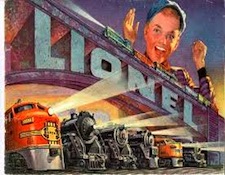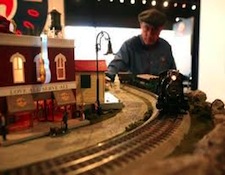It’s the time of year for saving money!
 At Christmas time, when I was a kid, every house I knew of
At Christmas time, when I was a kid, every house I knew of
had a Christmas tree and every Christmas tree had at least one electric train
running around it. I say at least one,
because an electric train was a favorite present to give a young boy then, and
– in those days before video games or even G.I. Joe – there was no knowing when
you might get one or get one more.
In those days, not only were there no video games, but about
the only “video” reference that any kid might recognize was “Captain Video”, a
kids’ TV hero that – if your family was rich enough or trendy enough to actually
own a television set, you could crowd around with your friends and watch on the
Dumont Network in all 8″ of its black-and-white glory.
Although television sets were rare then, electric trains were
ubiquitous. You could buy one (or additional cars or more track or trees or
signals or stations or even miniature people to buy tickets or wait for the
next train or its arriving miniature passengers) practically anywhere. Every
department store had its own electric train section in the toy department;
hobby and model shops sold them; and you could even buy an electric train set at
your neighborhood dimestore (Remember those?) or drugstore.
In those days, Lionel, the
leading electric train manufacturer, was king, the real train was the fastest (and
certainly the most luxurious) way to cross the continent, and none of us could
ever imagine things to be different.
Where, though, is Lionel
now? That’s the really interesting, and perhaps even scary, thing:
Lionel is still the biggest name in
the electric train industry, but so what? The electric train is now hardly even
a shadow of its former self, and exists more as a curiosity or an object of nostalgia
than as the popular toy or cultural expression it once was.
There are still places that you can buy them, of course, even
on the internet, and there are still people – probably many thousands of them –
who are still serious electric train fans; who have devoted tens or even
hundreds of thousands of dollars to their train sets; and who have dedicated
large portions of their homes (or even special separate buildings) to housing
them. With few exceptions, those people are male, affluent, and no longer young.
Does that sound familiar?

It used to be that HiFi was just as popular as electric
trains. After 1957, when the first
stereo records were released, HiFi and stereo, its latest exciting manifestation,
were everywhere, and everybody wanted them. Every city and even most small
towns had their own HiFi shops; you could buy a console “stereo” in any
furniture or department store; and all around the country, people sat and
“oohed” and “ahhed” at the sounds of ping pong games, marching bands, the Dukes
of Dixieland, and (you guessed it) steam locomotives roaring through their listening
room.
When I “went stereo” in 1957, with an Electro-Voice ceramic
stereo cartridge (for almost a year, the first and only stereo cartridge available)
on my Garrard record changer, I was fifteen years old, and had already been an
audiophile for three years. I wasn’t
alone. All my pals – fine gentlemen of equally tender years – were also
audiophiles, and, like me, had – even in mono days – bought Heath and Eico kits
and such used PA and recording studio equipment as we could afford or scrounge
and had built our own “systems”, hooking them up, for those of you who might
wonder, with our own “home brew” cables, made out of nickel-a-foot Belden
microphone cable and two-for-a-nickel cardboard-dielectric “tulip” RCA
connectors.
We were the vanguard of a whole new technology or perhaps
even a whole new lifestyle, and we were followed into HiFi fandom by most of
the country and, later, most of the world. The problem is that we who were the avant garde, of something new now find
ourselves to be, at least in the United States, the rear guard of something
that, like electric trains, we fear has had its day and may, like the electric
train industry, never really die, but never again have any relevance in the
real world.
In the last few months, I have attended several events
centered on two-channel High End audio – the new fancy name for what we used to
just call HiFi. The people I saw there were, with few exceptions, just as with electric
trains, male, affluent, and no longer young.
We kids who were its founders have stuck with it, but where
are the new kids to take our places?
Electric trains at least had their excuse for lapsing into
obscurity and nostalgia: Airplanes came along, as did a national network of
freeways, and, except for freight, trains no longer served any real function.
Not so for High End audio. Music has always stirred the human soul, and High
End two-channel audio is still better by far than any other medium or mechanism
for delivering it in all its glory.

If it’s not that HiFi has been technologically obsoleted,
what is it? Certainly High End Audio has become so expensive that it’s only the
very rarest kid who can afford even a used genuine High End system, but is that
all of it? The truth is that science and technology have advanced in the last half-century – so much so that even some
of today’s affordable “Mid-Fi” electronics and mini-monitor speakers can
provide a creditable performance, even as compared to some High End systems of
yesteryear. When you consider the price of a “Wii” system, or an X-box, or some
of the other things that kids DO buy, it becomes obvious that it’s NOT that
kids can’t afford it.
Can it be that they no longer love music? Or that they’ve
never heard a “live”, unamplified performance, so they don’t know what music
really sounds like? Is it possible that their ears have been destroyed by so
much loud noise, through earphones or otherwise, that they can no longer hear
the difference? Do they simply no longer care? Or, even if they DO care, can it
be that they have so many other options and involvements that they simply have
no time for good sound?
What do you think? If you have an idea, please let us know.
If there is a way we can keep our hobby/sport/passion from turning into the
electric train business, we need to do it!






And what are the most popular toys of 2012 across the globe? Stuffed toys. The trick to marketing anything is to make it appear current. Want to bring back toy trains the come up with a Green Train or a Bullet train and you are in business.
Seems to me its partly the price, the rather elitist atmosphere and also that even having spent a pile of dosh, the sound doesn’t turn out that good in comparison with the real thing if the source is digital. Vinyl is gaining something of a renaissance though so its not like that kids don’t know decent sound, rather they also want convenience nowadays and vinyl doesn’t deliver much in the way of that.
Ironically, while the younger generation parties with boom boxes covered with flashing lights, their graying audiophile relatives revere as sacred other boxes with flashing lights – called tube amps. Just so long as audiophiles sacrify expensive boxes trimmed with gold, titanium, marble and fine timber at the expense of simply enjoying great music, audiophiles will remain as a decadent and elitist aberration from the past. BTW, I too am greying and enjoy vinyl as well as digital. But then I always listen to the music, not to the boxes.
i’m reminded of alan parsons’ comment about how the difference between a music lover and an audiophile, was that the former used equipment to listen to their music, the latter used music to listen to their equipment.